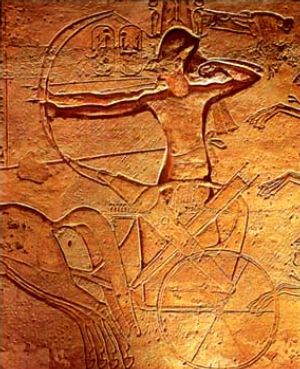
Ramses II at the battle of Kadesh.
that (four horse?) chariot rock art piece makes one wonder what the actual age of such rock art happens to be. :’) Great find!
http://www.metmuseum.org/toah/hd/tass/hd_tass.htm
...Tassili-n-Ajjer in Algeria is one of the most famous North African sites of rock painting. Its imagery documents a verdant Sahara teeming with life that stands in stark contrast to the arid desert the region has since become. Tassili paintings and engravings, like those of other rock art areas in the Sahara, are commonly divided into at least four chronological periods based on style and content. These are: an archaic tradition depicting wild animals whose antiquity is unknown but certainly goes back well before 4500 B.C.; a so-called bovidian tradition, which corresponds to the arrival of cattle in North Africa between 4500 and 4000 B.C.; a “horse” tradition, which corresponds to the appearance of horses in the North African archaeological record from about 2000 B.C. onward; ...
http://www.metrum.org/mapping/sahara.htm
...Our knowledge of the ancient Sahara was revolutionized by the publication, in 1957, or the results of Henri Lhote’s investigations of the rock paintings of the central Sahara. These paintings indicate that there was a time when chariots drawn by horses crossed the Sahara from the Mediterranean coast to the river Niger. This indicates that the process of dissication of the Sahara had reached a point in which transportation by river was no longer possible from the Great Chots to the Ahaggar and from there to the Niger, but the land could still support horses. One principle used by Lhote in dating this chariot route is the fact that the horses are portrayed on the rock painting according to style conventions that occur in Mycenaean art. Lhote assumes that the Mycenaeans, like the Greeks who followed them, had colonized Cyrenaica and that from there had advanced into the Sahara area...

Ramses II at the battle of Kadesh.